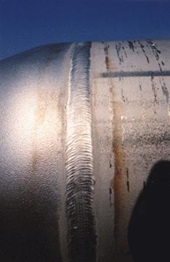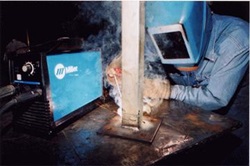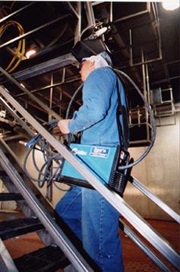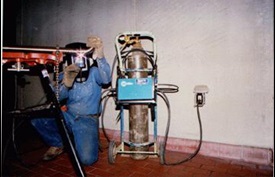Contracting and Fabricating Company Benefit From Fast Switch Technology of Maxstar 150 Welders
Print Article
The Maxstar 150 incorporates a new Miller technology called Fast Switch. Inverters based on Fast Switch technology operate at a frequency of 100,000 Hz (100 kHz), which is two to five times faster than current inverter technology, and more than 1,000 times faster than conventional welding technology. Fast Switch technology enables Miller Electric to remove weight and size from the inverter without sacrificing low-end arc performance or high-end power.
To characterize Lee's Contracting/Fabricating, Inc. as a company that thrives on field applications would be a huge understatement. Listen to Ryan Vanden Heuvel, company vice president - and son of founder and president Leon Vanden Heuvel - talk about the work they do and you would get the impression the company's 14 fabricators were never in the shop.
"That might be a little far-fetched, but it's not too far from the truth," said Ryan, who with his brothers Jay and Dave is a part owner of the 32-year-old Little Chute, Wis., company. "We do a fair amount of welding and fabricating in the shop, but we also do a lot of pipe fitting in the field: installations from wastewater and water treatment plants to paper mills and dairy processing facilities."
The company's get-up-and-go attitude has caused it to embrace Miller Electric Mfg. Co.'s new Maxstar 150 Series of DC TIG/Stick inverters.
"Because of our size we have to be versatile. Our fabricators are equally at home in the shop or out in the field, so it's important that we have welding equipment that is versatile as well," said Vanden Heuvel.
Fast Switch Increases Portability, Convenience
The Maxstar 150 incorporates a new Miller technology called Fast Switch. Inverters based on Fast Switch technology operate at a frequency of 100,000 Hz (100 kHz), which is two to five times faster than current inverter technology, and more than 1,000 times faster than conventional welding technology. Fast Switch technology enables Miller Electric to remove weight and size from the inverter without sacrificing low-end arc performance or high-end power.
The Maxstar 150, at 13.7 lbs., is five to 10 lbs. lighter than competitive units, yet boasts a 30 percent duty cycle at 150 amps (230 V primary) and a 5- to 150-amp welding range. To mechanical contractors like Vanden Heuvel, this means increased portability, convenience and flexibility.
 |
| Fig. 1 These beautiful weld beads were produced in the shop at Lees Contracting/Fabricating, Inc. Shop. With the power to weld schedule 10 stainless pipe in larger diameters, the Maxstar 150 produces a lot of weldments destined for water treatment facilities. |
"One day we might have six guys in the shop TIG welding 304L stainless pipe for a water treatment plant (see Fig. 1), the next day a paper mill wants us to do on-site maintenance and the day after that we're installing pipe at a cheese plant (see Fig. 2, 3)," Vanden Heuvel said. "By offering us more power per pound, Maxstar 150 reduces our capital equipment expenses because we can use it in the shop or the field."
The Maxstar 150 is available in three models including two with Lift-Arc.
Lift-Arc for Quality
Vanden Heuvel said his operators like the Lift-Arc start feature of the Maxstar 150 STL and STH.
"With Lift-Arc you touch the tip of the tungsten to the metal and hold it for just a split second, the argon starts to flow, and when you pull it back it's a nice clean start on the arc," he said. "It eliminates any pin holes or other defects; it's very clean starting and produces a consistent arc. When we're TIG welding pipe in the shop with the Maxstar 150, the guys can set up at their station and their tungsten lasts for five complete joints before it needs sharpening."
To weld stainless steel 16 gauge or less, Vanden Heuvel reports that remote amperage control through a fingertip control (for the field) or foot pedal (for the shop) helps prevent burn through, warping and crater cracking.
"When welding vertical up, it helps to vary input because the heat rises. With a remote control we can back off on the heat and maintain consistent penetration," he says. "With the post-flow set at one second per 10 amps you can always be assured of proper gas coverage without any waste. It also helps when you complete the weld. It craters out nice and eliminates cracking and pin holes."
 |
Fig. 2 Lees fabricator Mike Van Asten welds a stand with 3/32-in. diameter E7018 Stick electrode. Note the Maxstar 150 is plugged into a 150 V/15 amp primary and set at approximately 75 amps; thats power to spare.
|
Stick Power, Performance
To prevent the rod from sticking during arc start, which usually creates a weld defect, the Maxstar 150's Adaptive Hot Start function automatically increases the output amperage at the start of a Stick weld.
"We've been especially pleased with the Maxstar 150's ability to Stick weld 316L stainless with a 3/32 in. rod," says Lee fabricator Mike Van Asten. "It's a real clean start; you are not sticking it and losing the flux on your rod right away and wasting material."
 |
| Fig. 3 Lees fabricator Rick Miskoviak carries the 13.7-lb. Maxstar 150 up these steps, which are part of a hydraulically controlled aluminum platform the company developed to add safety for milk tanker operators in inclement weather. |
Other Maxstar-related Stick work includes welding support stands, brackets and hangers to support process pipe and "black pipe," the latter with an E6011 root pass and E7018 cover. While running a 3/32-in. E7018 rod takes about 75 amps (see Fig. 4) - well below the capacity of the Maxstar 150 - this wasn't always the case.
"We used to own some competitive inverters that worked OK for TIG welding, but you couldn't Stick weld with them. You'd blow a circuit breaker or overload the machine trying to Stick weld when plugged into a 115 V primary outlet," says Vanden Heuvel. "Since Miller came out with its small Maxstars, those machines sit on the shelf with an inch of dust on them."
For a given breaker size, the Maxstar 150 offers 30 percent more welding power than any other machine in its class because it features Auto-Line primary power management technology and power factor correction. While most of Lee's DC TIG work doesn't need this capacity, its Stick welding certainly does.
Vanden Heuvel credits his local distributor, Doug Marquardt of Interstate Welding Sales Corp., with exposing his fabricators to the Maxstar 150 inverters. "Doug saw them as another way to improve productivity compared to using Miller's XMT inverters, which weigh 76 lbs. The XMT is an important power source for the heavy duty jobs, but the light weight and portability of the Maxstar 150s is just too good for a lot of work," he said. "Our operators are so much more productive with them. It's a matter of using the right tool for the job, and the Maxstar 150 is right for us."
 |
Fig. 4 The Maxstar 150 Auto-Line technology enables Lees fabricator Rick Miskoviak to plug this unit into 115 V primary power or any single-phase primary power up to 230 V. This adds flexibility when working on different sites.
|